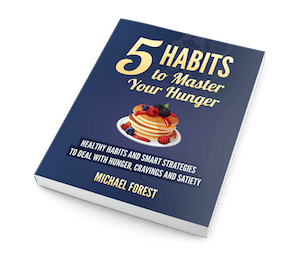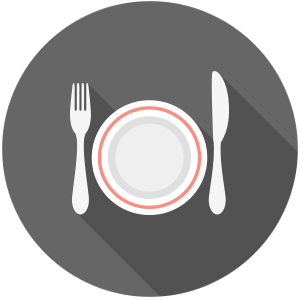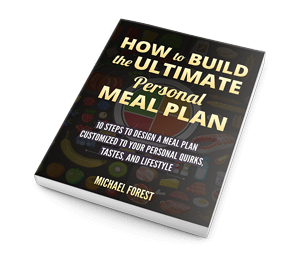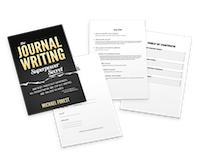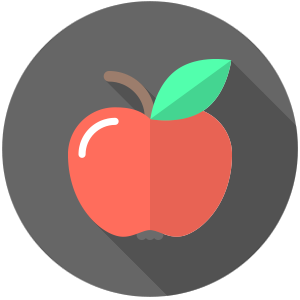
Mastering your hunger most definitely has to do with eating foods that “fill you up,” and some foods do this better than others, especially relative to how many calories you get in a reasonable serving.
Certain foods also provide more satiety when eaten in combination, because your brain needs to experience a variety of textures and tastes in order to really get the signal that things are good.
There are a lot of myths about this, mostly because of trendy carb superstitions and the current love of fat.
First, forget the insulin index, pretty much. It’s not that relevant in the real world. (For example, the body’s insulinogenic response to a food is affected if the food is eaten along side another food. How often do you eat a potato all by itself? Yeah, exactly.)
Also, at each regular meal combine a protein with either a fat or a carb (or a bit of both). Don’t eat foods in isolation. The body needs a variety of nutrients and textures in order to feel satiated.
You can look up the satiety index if you want, but generally speaking, here are a bunch of foods that do a crazy good job of filling you up, especially relative to how many calories they have:
- Anything that’s a lean protein (chicken, fish, turkey, extra lean ground beef, etc.)
- Heck, anything that’s a not-so-lean protein (steak, fatty fish, etc.)
- Potatoes, any kind. Yes, any kind. I used to like sweet potatoes more, but now I enjoy the white ones, with soft-boiled eggs and a bit of ketchup, all mixed together.
- Canned beans. For both taste and calorie content, I prefer pinto beans and black-eyed peas. Navy beans are pretty good too. Their high-fibre content is also good at blunting the insulinogenic effects of the high-sugar stuff you might want to have in a given meal as a treat.
- Eggs and egg whites. Egg whites give you more volume, but the fats in regular eggs are very good for you and provide a bit of satiety too. I eat whole eggs because otherwise I won’t have enough fat in my diet. (Seriously, if I were to follow my natural inclinations, my fat would fall down below 10g/day, and I start craving fats again until I actually get some.)
- (Duh.) Veggies provide lots of volume, especially lettuce, spinach, etc. But don’t overdo this. Lots of veggies = gas, and unpleasant trips to the bathroom.
- Other fruits are very good, but I have to admit grapefruit is champ when it comes to satiety. This is why that weird grapefruit diet exists. Um, don’t do that weird diet… But eat some grapefruit. Pineapple is my runner-up (and I actually enjoy the taste more).
- Brown rice and white rice. Another good carb source that provides a lot of satiety. Not my favourite, but some people swear by rice. I try to incorporate it just for variety.
- Salty-flavoured rice cakes and mini rice cakes. These are extremely convenient, and provide a decent amount of volume and satiety. Important note: The sugary-flavoured ones like caramel or apple cinnamon are not as good when it comes to hunger and cravings. (Yes, this is a huge bummer.)
- Hot cereals. Oatmeal is the traditional recommendation here, but I find Cream of Wheat is actually easier on my stomach, and frankly I prefer the taste. You could also go for oat bran or grits.
- Cottage cheese and Greek Yogurt. Here you can add mix-ins like protein powder or even some types of cold breakfast cereal. Cottage cheese, also, is waaay better in terms of taste if you blend it and add a bit of splenda, or use it as an ingredient in some other recipe: a topping for salad, and it’s a good way to make a protein shake taste more milkshakey and less “powder-in-watery,” etc.
- Also note that protein in general provides more satiety than the other two macronutrients, carbs and fats, but it provides the most satiety when combined with a bit of carbs or fats as well. Protein also has the added benefit of having a larger thermic effect of feeding. This means protein makes you burn more calories just eating and processing it than the other macronutrients.
But I am saying you should switch out other foods you’re eating for any of the foods above if you’re finding hunger is a problem, especially if you’re consistently hungry after a particular meal.
Also, I think if you look over the list again, you’ll also find that there’s a lot of room to experiment within the foods listed above. There are plenty of recipes online. Use Google. Ask healthy friends. (“Hey, what’s your favourite recipe for salmon?”)
Also related to the above, there are two relevant myths I want to mention.
A lot of people will suggest something like “nuts” because it is low on the insulin index and it’s totally this amazing wonder food. Uh, okay. Sure. But you get almost no volume. A handful of nuts will have a whole bunch of calories. Yeah, they’re good for you and they won’t spike your insulin. Uh… Hurray. Woooo? I guess?
Big deal.
That’s true of a lot of foods, except with those other foods, you’ll get way more actual food that you get to eat. Volume is important! I’m not saying don’t ever eat nuts. I’m saying they’re not magic when it comes to satiety. There are no “super foods.” There are just foods that have a few effects on the body, and often times it’s a give and take.
On the opposite end of the spectrum, potatoes have an undeserved bad reputation because of the insulin index, but that’s flawed thinking. Yeah, they do rate high on the glycemic index. Oh no. The bottom line is that they FILL YOU UP. Seriously, actually try a baked potato, and then tell me that, from your own subjective experience, that potato left you hungry.
(Spoiler: This won’t happen. It will sit in your stomach like a rock.)
There’s a reason why bodybuilders trying to get to crazy ripped levels of low bodyfat eat potatoes right up to contest day. Potatoes “stick to your ribs.”
Your grandmother understood this, and that’s why she cooked you steak and potatoes. (She was also, it turns out, mixing a protein [steak], with a carb [potatoes]. Seems like your Grandma really knew what was up.) Society has worked hard to very wilfully forget all this.
Well, society is really dumb sometimes.
This is kind of obvious, but it needs to be said.
Highly processed, super sugary foods often make you more hungry, not less. One of the reasons why Paleo, Atkins and low-carb diets seem to work so “magically” at controlling hunger is you no longer eat these highly-processed, sugary foods. But, as you can see above, many carbs that are banned on these diets (e.g. potatoes or rice cakes) are actually great at filling you up, so it makes no sense to avoid those foods as well.
In my opinion, the absolute worst foods for hunger are those little 100-calorie packets of mini Oreos or mini cookies or whatever.
Like, I get it. I empathize.
The idea of controlling portion size actually seems reasonable. And you really want a bit of Oreos (or whatever brand it may be) or a bit of a sugar hit.
Who doesn’t?
But honestly, if you’re hungry, those tiny packets won’t accomplish anything.
“But I just have a tiny sugar craving!”
Yeah, I know. Seriously, I'm telling you, I get them too. I'm a sugar fiend.
But the problem is you’ll still have that “tiny” sugar craving after you eat the packet, because you won’t be satisfied by it.
At all.
You won’t even feel it hit your stomach. All you’ll feel is the weirdly increased craving you seem to get an hour later. (And this is all doubly true if you eat only the packet and you don’t combine that sugar hit with a fat or a lean protein or something, which would otherwise blunt the blood sugar response.)
If you do have a snack like this, you might also experience the psychological “what-the-hell” effect. [1]
The “what-the-hell” effect goes something like this:
“Well, gosh, I’ve already had some ‘bad’ food, so what the hell, I might as well just have more.”
[ Cue massive binge. ]
For the most part, you should save the really sugary stuff for cheat meals, spike meals and spike days (and I’m about to talk about those—so hold on).
On regular days I mostly satisfy cravings with Splenda in my oatmeal or cream of wheat, or protein powder and Splenda in Greek yogurt or cottage cheese.
Listen: I love sugar. I am a crazy sugar addict, with totally unrefined tastes. I have the taste buds of a three year old screaming for his mom to buy him a second box of Count Chocula. Just give me a big batch of cookies over fancy French cooking any day.
And yet… for my regular diet days,a bit of Splenda in my oatmeal or cream of wheat — also combined with a protein like eggs — satisfies my sugar cravings. I give my taste buds and my brain a variety of tastes, textures, macronutrients, and micronutrients, so my brain says, “Okay, cool, I guess I'm satisfied for now.)
If you must, then yes, you can probably get away with a treats in your regularly scheduled meals if you only have two or three meals, because they’re larger than if you ate six small meals per day, and there’s more room for experimentation. And the sugar spike will have less of a negative effect when combined with a bunch of other foods.
However, as St. Augustine put it, “Abstinence is easier than moderation.” (That's a topic unto itself, related to calorie counting, diet rules, and more.)
I prefer my regular meals to be regular with very little experimentation. My cheat meals are saved for that, and I don’t hold back or worry about moderation, because that’s no fun, frankly.
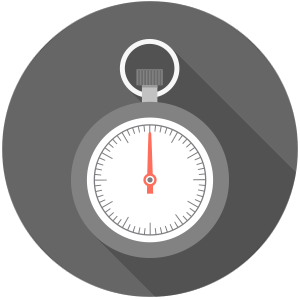 Check out my post on three principles of hunger and dieting if you haven't already.
Check out my post on three principles of hunger and dieting if you haven't already.
When combining and thinking about foods and meals, one thing to be aware of is that hunger exists on a longer time scale than three hours.
This means that there’s more to hunger than thinking “hmm, this meal kept me satiated for two hours, but this other one kept me satiated for two and a half!”
For example, if you’re on a diet, hunger is cumulative. What fills you up on day 1 of your diet will leave you super hungry on day 30. Trust me on this. You need to pay attention to it, and ensure that you still don’t reach the point where, “I am hungry” (normal) means “I am low on energy and feel like a huge butt all the time” (not normal; bad; danger zone!).
Another important example is cravings that add up cumulatively. For example, my sense of being immediately satiated is always accomplished better with a protein and a carb, not a protein and a fat. Always. If I eat a protein and fat, I kind of want to eat again in a few hours, before my scheduled meal.
But that's only the immediate effect.
Within two to three days, if I’m not getting enough fats, I find I just… start… cheating on my diet.
For a long time I couldn’t figure out why, until I made this realization about hunger. Partly it was from talking with Scott Abel and getting a broader understanding of human metabolism. [2]
In other words, having a few more fats in my diet (relative to what I tend to instinctively gravitate towards) makes me a bit more “hungry” before my next meal in a way… but it also seems to make it easier to not cheat on my diet.
Hmm, I wonder why? It’s because there’s more to hunger and cravings than an immediate sense of satiety in your stomach. It’s a complex relationship between your stomach and your brain, and hormones and blah blah.
(So, TL;DR: Eat a variety of foods, make them whole foods mostly, and don’t cut out entire food groups, even if sometimes that “seems” more satisfying “at first.”)
Enjoying the Guide?
Get the Revised and Expanded Edition (available now on Amazon)
New Sections
3 Key Principles (...About Your Hunger and Cravings)
"Am I In the 'Sweet Spot' of Hunger?" Assessment Guide
8 Factors Affecting Your Ability to Assess Your Own Hunger
"Do I Need a Cheat Meal?" Assessment Guide
Introduction.
Dealing strategically with hunger, cravings, and metabolic compensation.
Habit 1.
Eat in such a way that you train both your stomach and mind to only be hungry when it’s time to eat.
Habit 2.
Pick (and combine) foods that satiate YOU.
